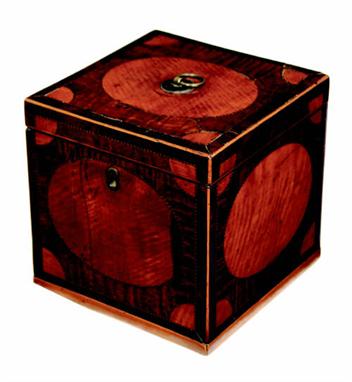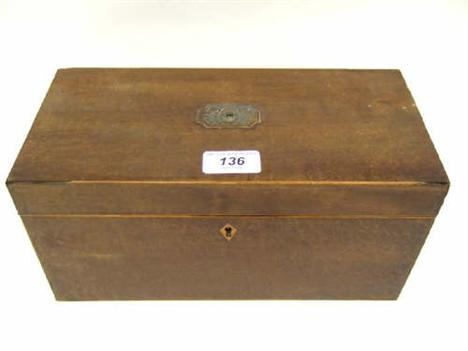81699 Preisdatenbank Los(e) gefunden, die Ihrer Suche entsprechen
81699 Lose gefunden, die zu Ihrer Suche passen. Abonnieren Sie die Preisdatenbank, um sofortigen Zugriff auf alle Dienstleistungen der Preisdatenbank zu haben.
Preisdatenbank abonnieren- Liste
- Galerie
-
81699 Los(e)/Seite
A George III rolled paper octagonal tea caddy, the hinged cover with a later twin plate mirror revealing a later foiled interior with marquetry cover, the panelled glazed sides with oval and urn motifs having crushed mother of pearl and ruby crystal backgrounds, the central front panel with an oval watercolour of a waterfall, 5.25in (30.25cm) h, 6in (15cm) w. Two glass panels cracked.
An 18th century German satinwood and kingwood parquetry tea caddy, with a moulded edge and a hinged cover with a cast gilt brass handle, revealing a triple divided interior above a cedar lined side drawer with a button release, the moulded edge base on gilt brass claw and ball feet, 8in (20.5cm) h, 11.5in (20.9cm) w.
A "Peter Pan" miniature folding gramaphone in leather case, a Reliance radio receiver in mahogany case, a late 19th century stereo card viewer with gilt brass and porcelain mounts, a mahogany twin division tea caddy, a 19th century gilt metal pedestal boat shaped bon -bon dish, a glass powder bowl and cover with gilt metal mounts, and a carved stone apple, (7), (A/F).
An early 19th Century Mahogany Boxwood line inlaid and lacquered Brass Mantel Clock, signed Thoms Ernshaw of London, the balloon shaped case surmounted by a caddy top, with ball finial, over fish scale panels, with heavy cast carry handles to a waisted mid section and plinth base raised on four bracket feet, to a moulded Brass bezel with convex glass enclosing a signed Roman and Arabic enamel dial, with pierced blued steel Thwaites & Reed type hands, to a circular Brass twin fuse movement, with back plate signed and profusely engraved with floral foliate and urn decoration, and plates united by five knopped pillars with anchor escapement and strike on a bell, height 26"
A late 17th century walnut and floral marquetry month-going longcase clock By Joseph Knibb the twin train movement with anchor escapement striking the hours on a bell, signed to the lower margin: 'Joseph Knibb Londini Fecit', the 11" brass dial with chevron engraved perimeter and cherub mask spandrels around a silvered Roman chapter ring enclosing a matted centre with date aperture, the hood with caddy top, blind fretwork friezes and spire finials above a long runk door with central armorial of a crown supported by griffins, on a stepped apron with bracket feet, the whole inlaid flower-filled jardinieres and perched birds within line inlaid and trailing vine borders 236cm high Note: Joseph Knibb was born in Oxfordshire and traded in clocks in Oxford with his brother John. The most renowned member of a renowned family he was classed as a clock, watch and turret clockmaker with Tompion and Quare and circa 1670 he moved to the 'Dyal, Serjeants Inn, Fleet St.'(later Suffolk St.) London. Knibb made many celebrated clocks including Prince Rupert's night lantern for Charles II, the turret clocks for Wadham College, and the State Entrance of Windsor Castle.
A mid 18th century mahogany framed chair back settee the curved back with double paper scroll crestings flanking a central carved scallop shell above a pair of solid vase-shaped splats, similarly carved with scrolls, the outscrolling arms boldly carved with lion masks, each with bared teeth and finely carved trailing manes, the balloon-shaped drop-in seat, with a caddy moulded rail and damask upholstery, on three front scallop shell and leaf carved cabriole legs ending in claw and ball feet, the two rear legs of plain outswept form; together with a pair of associated side chairs, of near-matching design (3) Settee: 158cm wide, 106cm high, 56cm deep (seat 47cm high)
-
81699 Los(e)/Seite




















































